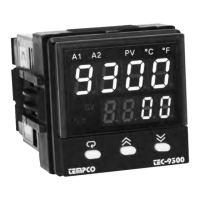81
A–3 Glossary
Absolute zero: The lowest theoretical temperature. At absolute zero, a
body would have no molecular motion of heat energy. Absolute zero is
the zero point on the Rankine and Kelvin scales. (-273.15°C or -
459.67°F)
AC: Alternating Current; an electric current that reverses direction at
regularly occurring intervals.
Accuracy
Calibration accuracy: The potential error of a device compared to
a physical constant or agency standard.
Control accuracy: Maintaining a process at the desired setting. The
errors or combination of errors in the entire system including the sen-
sor, control, power, load and design inefficiencies affect control accu-
racy.
Display accuracy: The amount of potential error between a meas-
ured value and the control’s displayed value.
Set point accuracy: The potential error between a measured value
and the control setting.
Alarm: A control condition or function, indicating that the process is a
predetermined amount above or below the set point.
Alpha (
α
): The average percent change in resistance per degree of a pure
metal resistance device between 0° and 100°C. Usually designated by the
Greek letter alpha, α with units of ohm/ohm/°C. The common alpha for
a platinum RTD is 0.00385ohm/ohm/°C.
Ambient compensation: The design of an instrument such that
changes in ambient temperature do not affect the readings of the instru-
ment.
Ambient temperature: The average or mean temperature of the sur-
rounding air which comes in contact with the equipment and instruments
under test.
Ampere (amp): A unit used to define the rate of flow of electricity (cur-
rent) in a circuit; units are one coulomb (6.25 x 10
18
electrons) per sec-
ond.
Analog indication: A meter with graduated scale and a pointer that
moves to indicate process condition.
Analog output: A voltage or current signal that is a continuous func-
tion of the measure parameter.
Analog set point: Potentiometer adjustment of the control setting.
ANSI: American National Standards Institute
Anti-reset windup: This is a feature in a three-mode PID controller
which prevents the integral (auto reset) circuit from functioning when
the temperature is outside the proportional band.
ASME: American Society of Mechanical Engineers.
ASTM: American Society for Testing and Materials.
Automatic reset (Integral): The integral function of a control that
automatically compensates for the difference between the set point and
the actual process temperature. A signal moves the proportional band up
or down to correct for the droop or offset error.
Automatic tuning (of control parameters): A control that calcu-
lates the optimum PID parameters with a built-in software algorithm to
eliminate manual tuning efforts.
AWG: American Wire Gauge.
Bandwidth: A symmetrical region around the set point in which propor-
tional control occurs.
Baud rate: In serial communications, the rate of information transfer in
bits per second.
Blackbody: A theoretical object that radiates the maximum amount of
energy at a given temperature, and absorbs all the energy incident upon
it. A blackbody is not necessarily black. (The name blackbody was cho-
sen because the color black is defined as the total absorption of light
[energy].)
Boiling point: The temperature at which a substance in the liquid phase
transforms to the gaseous phase; commonly refers to the boiling point of
water which is 100°C (212°F) at sea level.
Btu: British Thermal Unit. The quantity of thermal energy required to
raise one pound of water 1°F at or near its maximum density (39.1°F).
Bumpless transfer: The smooth, automatic transition from automatic
control (closed loop) to manual control (open loop). The control output
is maintained during the transfer.
Burst proportioning: A fast-cycling output form on a time proportion-
ing controller (typically adjustable from .2 to 4 seconds) used in conjunc-
tion with a solid state relay to prolong the life of heaters by minimizing
thermal stress.
Calender-van Dusen equation: An equation that defines the resist-
ance-temperature value of any pure metal that takes the form of
R
T
=R
o
(1+AT+BT
2
) for values between the ice point (0°C) and the freez-
ing point of antimony (630.7°C) and the form R
T
=R
o
[1+AT+BT
2
+C(T-
100)T
2
] between the oxygen point (-183.0°C) and the ice point (0°C).
Calibration: The process of adjusting an instrument so that the indica-
tion is accurate compared to the actual value.
Calorie: The quantity of thermal energy required to raise one gram of
water 1°C at 15°C.
Cascade: Control in which the output of a secondary or inner control
loop is the set point for a primary or outer loop. The primary loop, in
turn, determines the control action.
CE: A mark that designates compliance with European Union (EU)
requirements for products sold in Europe.
Celsius: (Centigrade) A temperature scale with 0°C defined as the ice
point and 100°C as the boiling point of water at sea level.
cfm: The volumetric flow rate of a liquid or gas in cubic feet per minute.
Chatter: The rapid cycling on and off of a relay in a control process due
to insufficient bandwidth in the controller.
Closed loop control: A control system in which process temperature
changes are detected by a sensor. The feedback from the sensor allows
the control to make adjustments for accurate system regulation.
Cold junction compensation: A temperature sensitive device that
prevents changes in the ambient temperature from affecting the cold
junction of a thermocouple.
Common mode rejection ratio: The ability of an instrument to
reject interference from a common voltage at the input terminals with
relation to ground. Expressed in dB (decibels).
Control loop: The basic control loop of any automatic control system
consists of:
1. variable (process)
2. sensor
3. error detector (of control)
4. control
5. final control element (relay, SSR, SCR)
6. temperature indication
Control mode: The method in which the control restores the system
temperature to set point. On/Off, proportional, and PID are the most
common control modes.
CT: Current Transformer

